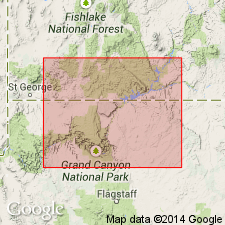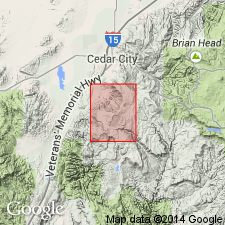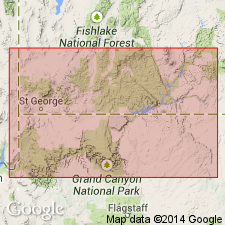
- Usage in publication:
-
- Cedar City tongue*
- Modifications:
-
- Named
- Dominant lithology:
-
- Mudstone
- Siltstone
- AAPG geologic province:
-
- Great Basin province
Summary:
Named as a tongue of the Kayenta formation of Glen Canyon group for exposures (the type locality) 2 mi east of Cedar City, east of Red Hill, Iron Co, UT in the Great Basin province. Is identifiable locally where the Kayenta is divided into parts (ascending)--the lower part and the Cedar City tongue by a tongue of the Navajo sandstone of the Glen Canyon group. The lower part of the Kayenta is overlain by the Shurtz sandstone tongue (new) of the Navajo. The Cedar City is underlain by the Shurtz and overlain by the main body of the Navajo. Cedar City includes units 28, 29, 30 (Thomas, Taylor, 1946, section measured on Coal Creek) and units 23, 24, 25 (Coal Creek section republished by Gregory, 1950). [These units not redescribed in this report.] Composed of non-resistant reddish-brown, locally streaked gray mudstone and silty mudstone, and red-orange to light-gray, locally mottled siltstone. Is 425 ft thick along Coal Creek; is 720 ft thick along Shurtz Creek. Increase in thickness from Coal Creek south is accompanied by a decrease in thickness in the underlying Shurtz. Of Jurassic? age. [No stratigraphic figures.]
Source: GNU records (USGS DDS-6; Denver GNULEX).

- Usage in publication:
-
- Cedar City tongue*
- Modifications:
-
- Overview
- AAPG geologic province:
-
- Great Basin province
Summary:
Mapped (geologic map) in Iron Co, UT in the Great Basin province, as an upper tongue of the Kayenta formation of the Glen Canyon group, above the Shurtz sandstone tongue of the Navajo sandstone and below the main body of the Navajo. Forms strike valleys in the north-central to west-central part of quad. Composed mostly of non-resistant, red-brown, locally gray mudstone and some orange, gray, white siltstone that occurs in beds 1 to 5 ft thick. Contains features of shallow water deposition--ripple marks, mudstone pellet layers.
Source: GNU records (USGS DDS-6; Denver GNULEX).

- Usage in publication:
-
- Cedar City tongue*
- Modifications:
-
- Age modified
- AAPG geologic province:
-
- Great Basin province
Summary:
Age of Kayenta Formation of Glen Canyon Group shown on a stratigraphic diagram as Sinemurian, Pliensbachian, and Toarcian, or Early Jurassic, rather than Jurassic? as previously assigned. Age modification of Kayenta and hence of Cedar City as a tongue of the Kayenta based on identification of Early Jurassic palynomorphs in the older Whitmore Point Member of the Moenave Formation. [Age of Cedar City, though name not used in this report, must also be Early Jurassic. Cedar City used locally in southwest UT in the Great Basin province.]
Source: GNU records (USGS DDS-6; Denver GNULEX).
For more information, please contact Nancy Stamm, Geologic Names Committee Secretary.
Asterisk (*) indicates published by U.S. Geological Survey authors.
"No current usage" (†) implies that a name has been abandoned or has fallen into disuse. Former usage and, if known, replacement name given in parentheses ( ).
Slash (/) indicates name conflicts with nomenclatural guidelines (CSN, 1933; ACSN, 1961, 1970; NACSN, 1983, 2005, 2021). May be explained within brackets ([ ]).

